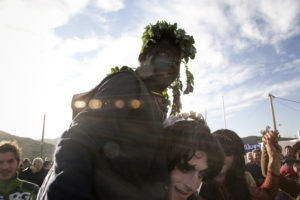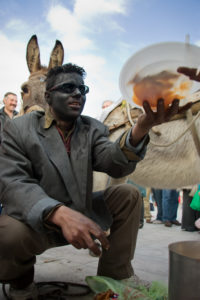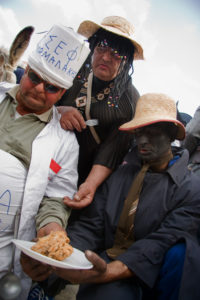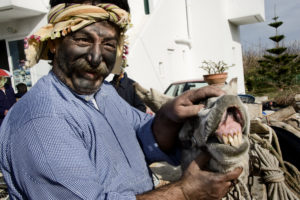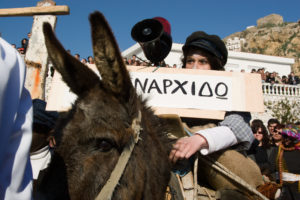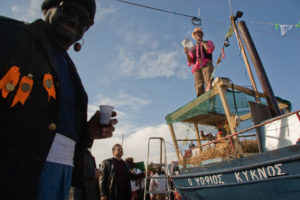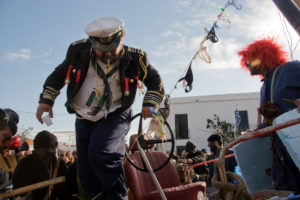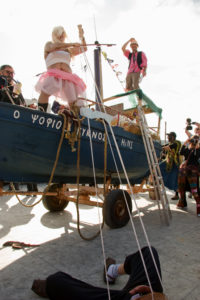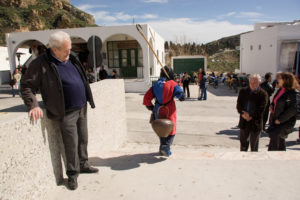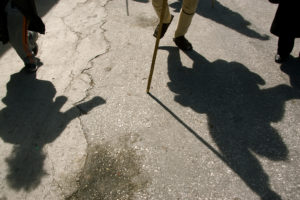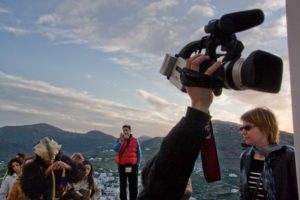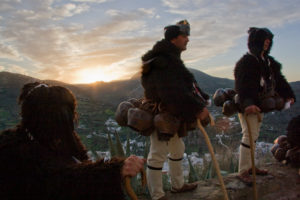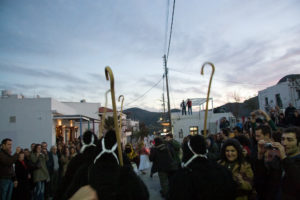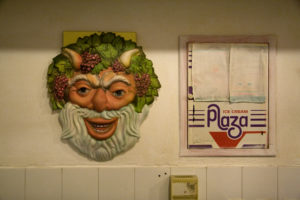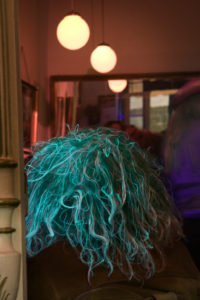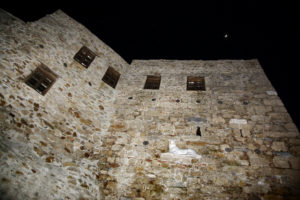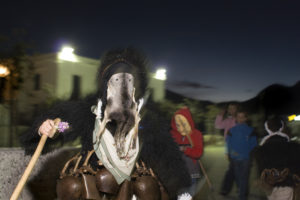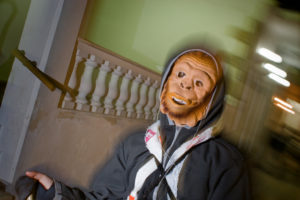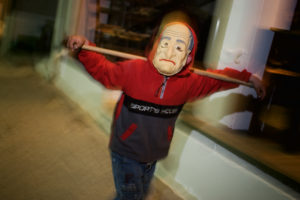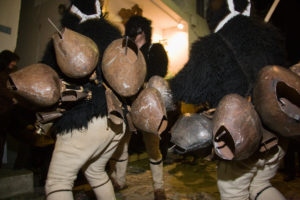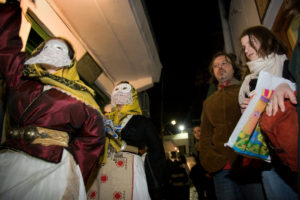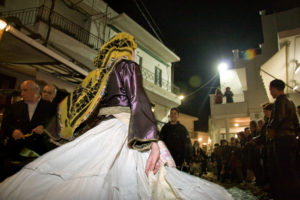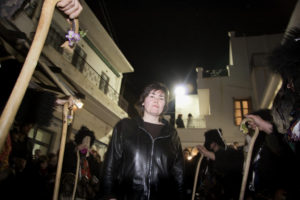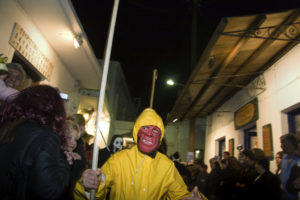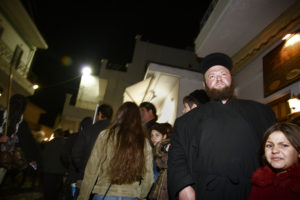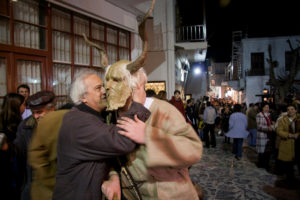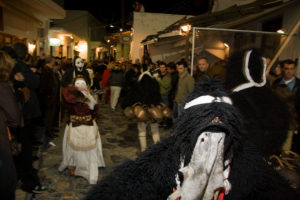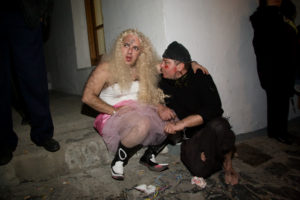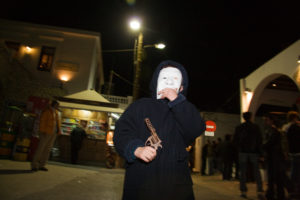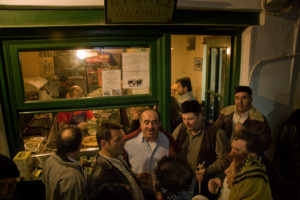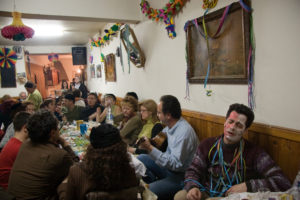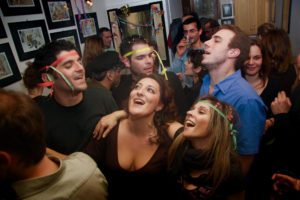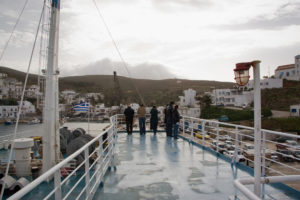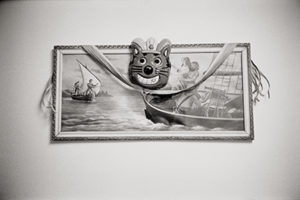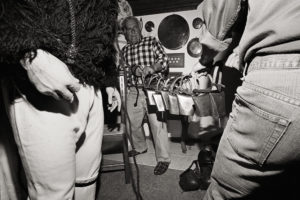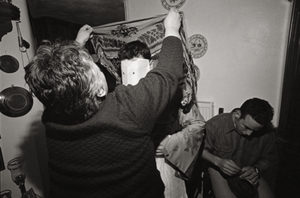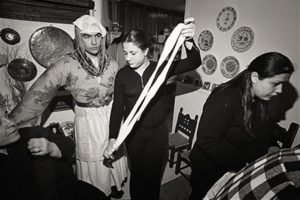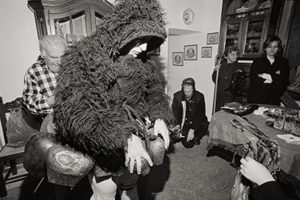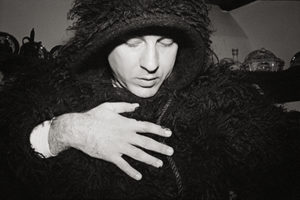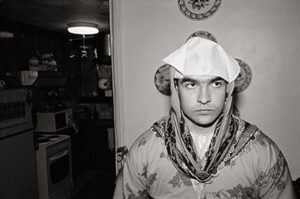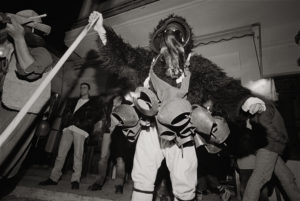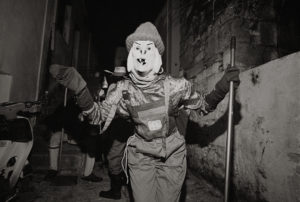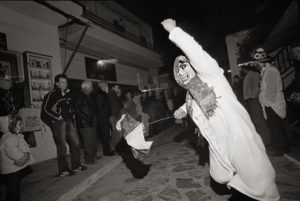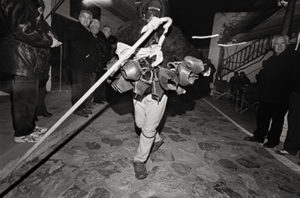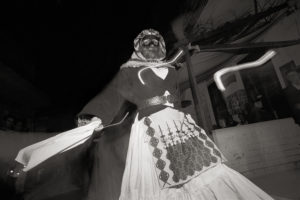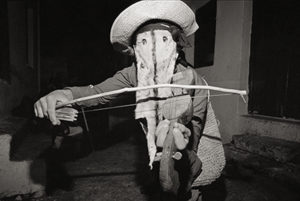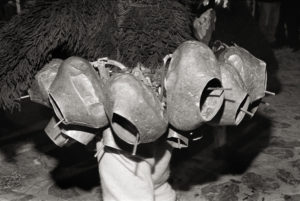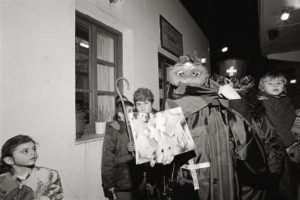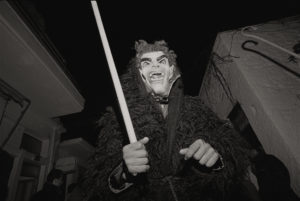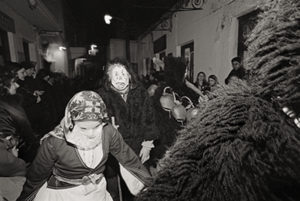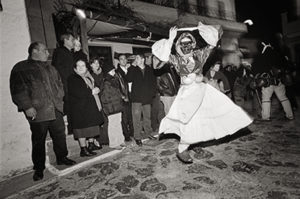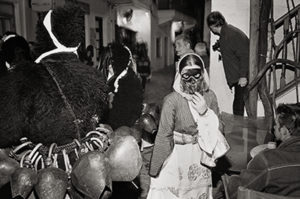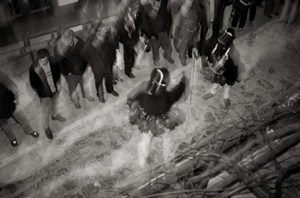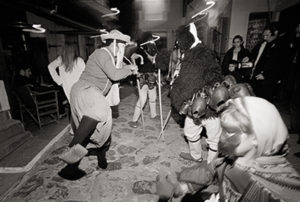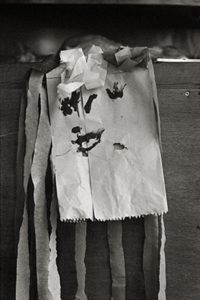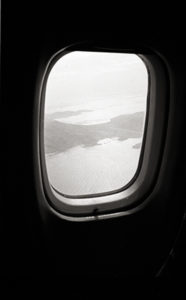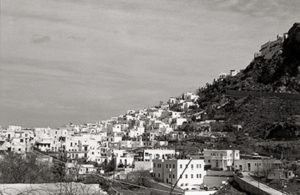
Carnival as a ritual event, as a rite de passage, and as a source for musical creativity has been the topic of a wide range of publications inside and outside of ethno musicology—but none has ever reached the surprising experimental character of the multimedia publication, Skyros Carnival. It is highly exciting to see the complementary interplay between the four dimensions of sound, text, photography, and video in this publication. The photography by Dick Blau takes a highlighted role in this interplay, as it is employed not as a mere illustration, but as an aesthetic foundation for the issues dealt with in the text…a groundbreaking example for a new way of writing sensual ethnography in the twenty-first century.
Eckehard Pistrick, 2013 Yearbook for Traditional Music
Noisy images, colourful sounds: Representing the senses of the carnival body
[A reference to the publication: Skyros Carnival. Photographs by Dick Blau, Essay by Agapi Amanatidis and Panayotis Panopoulos, CD + DVD by Steven Feld. Santa Fe, New Mexico: VOXLOX, 2011. ISBN: 0-945401-46-9].
Panayotis Panopoulos
University of the Aegean
Abstract
Consecutive explosions of images, colours, shapes, and movements. An acoustical rumble of overlapping sounds, noises, spoken words, and musics. Carnival figures mixing with spectarors, exchanging roles and bodies. Blinding voices and deafening, disorientating movements. Vibrating bodies, losing balance. Concealments and revelations. Presences and absences. Carnival tends towards an immensurable material and bodily extroversion, a sensual and sensory paroxysm. Daily habits and activites, ordinary spatial and temporal arrangements, are suspended. Boundaries are violated, the closed open and the open close. Things turn upside-down. The high turn low and the low turn high. In the “reversed” world of the carnival, the senses infiltrate one another, creating a new sensory order – disorder, an idiosyncratic carnival synaesthesia. How is this special, carnival interpenetration of the senses to be conveyed? Which is the most appropriate medium and in which genre of representation does it belong? Is it ethnography or art more appropriate for this purpose? How is our perception influenced by carnival synaesthesia and how does it affect the representation of the senses of the carnival body? The collaboration of four persons, one photographer, Dick Blau, two ethnographers, Agapi Amanatidis and Panayotis Panopoulos, and one anthropologist/ soundscape composer/ film-maker, Steven Feld, is a mixed, anthropological – artistic exploration, a multimedia project aiming at a multisensory representation of the carnival of Skyros island in Greece.
I.
When I first sent the photograph by Dick Blau presented in the cover of Skyros Carnival to Eckehard Pistrick, in September 2009, he kindly replied to my e-mail after a few days saying that he liked it, “although it is a little menacing for carnival”. Here you can see some more pictures by Blau from the carnival but, unfortunately, you can not listen to the wild carnival soundscape compositions by Steven Feld, from our collaborative project on Skyros carnival, one of the wildest and certainly the noisiest carnival in Greece. The fourth member in our team is Agapi Amanatidis, a Greek-australian social anthropologist who has done her PhD research on Skyros carnival. Along with Agapi, I have co-authored the text for this multimedia project. Nevertheless, since we have worked together in all the stages of the project, from fieldwork to editing, I believe that we would better describe it as a collective work, despite our different individual contributions to it. In this collaborative project, we were all motivated by a strong urge to pursue issues of representation in both anthropology and art, their mutual influences and expressive potentials.
In this paper, I will focus on three main issues related to our work on Skyros carnival: 1) the extremely important symbolic role of sound in carnival celebrations, the significance of the sense of hearing in perceiving and participating in carnival activities, 2) the great importance attributed to all kinds of audiovisual recordings of the ritual and their organic incorporation into carnival celebrations, and 3) the transformation of the carnival, its renewal and the changes affecting its meanings, the transgression of local boundaries and limitations that might have defined it in the past, the never-ending play of locality with a widening field of references and significations. I will try to show that these three issues are tightly interwoven, while they also pose an interesting framework of questions, which can offer a clue for a reflexive perspective concerning the limits and the potentials of representation in artistic/ anthropological media.
Before getting into these more specific issues, I would like to start with a few concise remarks on the carnivalesque body, the transformations of both individual and social bodies in carnival. Things that we take for granted in terms of space and time boundaries in everyday life, the identity and differentiation of our material individualities are lifted in carnival. Orderly habits and activites, ordinary spatial and temporal arrangements, are suspended. Standard rules of logic and contradiction are reversed. Boundaries are violated, the closed open and the open close. Things turn upside-down. The high turn low and the low turn high. Crear-cut categories blur and boundaries flicker. Carnival tends towards an immensurable material and bodily extroversion, a sensual and sensory paroxysm. Individual bodies and body parts are dismembered and rearticulated in new, mixed and often monstrous unions. In carnival, bodies protrude and gape; monstrously huge noses, humps and penises, gaping mouths and terrifying bodily holes allow for the penetration of bodies into one another, the unification of individual bodies in wider collective entities, without clear-cut boundaries and identities. The senses of carnival bodies do not function as well-defined and clearly orientated mechanisms of perception. In the “reversed” world of the carnival, the senses infiltrate one another, creating a new sensory order – disorder, an idiosyncratic carnival synaesthesia, the special sensorial (dis)order and sensuality of the carnivalesque social body.
II.
I will first examine the issue of sound in carnival, what we could also define as the carnivalesque soundscape. The notion of soundscape transfers us, both sensorially and theoretically, from visual to acoustic space; it realizes this space as an open, multi-dimensional field of wide considerations, rather than a simple framework of stimuli of a sonic nature defined strictly by the sonic elements dominating a specific place and time. A soundscape does not simply refer to – and it certainly does not exhaust itself in – an objective description or representation of the sonic characteristics of a specific environment; it is the social and cultural construction of this sonic environment. It does not concern sounds per se, but their perception, their social and cultural evaluation. Furthermore, the notion of soundscape and its several uses for more than three decades now has dissolved the distinction between textual and acoustic forms of representation of the sonic environment.
In Skyros carnival, sound literally transforms the village into a festive space, ready to envelope the activites of the carnivalesque social body; carnival sound redefines ordinary space and time, the routines of everyday life, the familiar routes, stops and movements; the usually segregated and differentiated village spaces are unified and turned into a homogenized field of collective action and transgression. The strictly enclosed private village spaces, the visually segregated houses that are hidden behind closed doors and high fences are flooded by carnival sound-making, their clearly demarcated boundaries are overwhelmed by a dominating intruder, which is impossible to ignore. A tightly woven web of strictly defined social relations and cultural meanings is impregnated at its structural kernel by carnivalesque sound, activating pores through which sound floods every corner of the village, every single niche in the island’s social structure, transforming it for some time into something else. The variable sounds of the carnival create sensorial inspissations and dilutions, movements and stops, which acquire their meanings in relation with and in opposition to the differentiating characteristics of the everyday life in the community. The sonic excess of the carnival densifies the alterity of festive time, it breaks down linear time progression. The dilution of boundaries, the reversal of ordinary statuses, the dethronement of the socially powerful and the enthronement of the low and the obscure, that characterize every carnival, are in this case based on the dynamics of sound, its ability to transgress physical and visual boundaries, to unify distinct entities and areas of activity, to create wider unions and sonorous envelopes, a collective space and time.
The soundscape of Skyros carnival is dominated by the sound of animal bells worn by the yeri (m. oldmen). Yeri are men dressed in black woolen gowns, white shepherds’ rough trousers and a mask made of little goats’ skins, yet the most spectacular aspect of their attire is the animal bells they wear round their waist. Bells, as well as the whole attire of the yeri, has a mythical origin and strong symbolic connotations. It is exactly this specific sound, this bellscape, that gives the festive tone to carnival celebrations year after year, that makes the carnival what it is for the people of Skyros. In Skyrian narratives concerning the carnival, you can always trace, in multiple variations and repeated phrases, this common motive, a shared knowledge that it is a crucial need for them to immerse themselves yearly into this sound experience, which coexists and reverberates along with many other festive sounds. In earlier days, carnival bells used to be the loudest sounds of the community. No other natural or mechanical sound would surpass their loudness, with the exception of loud thunders. Nowadays, of course, things have changed. But still, the main arena of the carnival is the main street of the village market, narrow and stone-paved and free of cars, where the bells of the yeri mainly compete with the music emitted from the screaming loudspeakers of the sound systems of local restaurants, bars and tavernas. The carnival village is literally vibrating with ear-piercing sound explosions of bells, songs, voices, delirious screams, extrovert movements, contacts and colourful blasts.
Since we are much more acquainted with visual perception and its metaphoric load, it would probably be much more enlightening (and this is certainly not an accidental choice of a metaphor) if I used some visual references and analogies in order to convey this sensory experience, although it is often hard to confine myself to them alone, since in this case the visual bears or blends with the tactile, which bears or blends with the acoustic, which bears or blends with the olfactory, and so on. The carnivalesque rumble is the sea in which all revellers swim, without always noticing the buoyancy that the carnival offers. If someone would suddenly turn off the sound in this dominating sonorous envelope, everyone moving in the carnivalesque acoustic space would literally loose a fundamental foundation, a basic hitch to reality, everything would suddenly become disturbingly uncanny. It is exactly this technique, of a sudden halting of sound, that is used by cinema directors when they want to state the sudden intrusion of the uncanny and the infringement of familiar space and experience in scenes of extreme crimes or unexpected blasts of violence, scenes that make us shudder with fear. Carnival is the opposite of thriller…
III.
The second issue I would like to refer to is the plethora of local visual recordings and representations in Skyros carnival. One would even dare to say that a new figure has recently arised and complemented the troupe of the other typified carnival figures. I’m talking about the hundreds of people, both locals and visitors, who ceaselessly record every single movement of the revellers with photo and video cameras in hand.
Cameras are omnipresent. They have turned into an indispensable part of all carnival activities, both the more well-established and formal perfomances and the more peripheral and undefinable ones. Visual recording as a symbolic confirmation of presence, of “being there”, is complemented by many other performative practices, which actively encompass it in carnival space and time. Digital images are exchanged on the spot, displayed among friends and relatives, collectively evaluated, saved or deleted to make more digital “space” for the new ones.
The visual dimension of Skyros carnival has been thoroughly examined and discussed through the years. Costumes, movements, masks have been repeatedly traced, recorded, demarcated and classified by folklorists, historians, anthropologists, photographers and directors. Today, visual recording has passed from “professional” hands to the hands – and the mechanical “eyes” – of all the spectators of the events, who do not actively participate in them, although active and passive roles take turns for participants in the carnival. Everything is recorded again and again, year after year, creating a quasi-archive of innumerable successive representations for all uses and with variable meanings. In many cases, people recording the activities are more than those actively participating in them. Things change when we consider the sound of carnival, although sound is such an important part of the carnival’s experience. The sound part is saved rather in passing in video recordings, while it is totally lost, at least in its literal sense, in static images.
Visual recordings have a history of their own or, we should better say, they have a formal and many other, smaller and more informal, stories to tell, personal stories, family stories, stories of friendship. For years, Skyros carnival has often been the object of Greek State TV documentary films with a rather folkloristic content; these films have thoroughly established an official perspective and a formalized narrative concerning carnival masquerades and activities, an official version of their meaning for state ideology. These official recordings have gradually become part and parcel of the local stock knowledge concerning the carnival, while the people of Skyros often refer to their authority in order to draw information or details concerning what is considered to be the “authentic” meaning of carnival customs. The more recent and informal forms of recording, on the other hand, produce multiple parallel histories or intersecting readings of the carnival activities, transforming thus, in some cases slowly and gradually and in other cases rather suddenly and dramatically, the carnival’ s contents and meanings. Every new representaion of the carnival wishing to overcome the limits of a strictly folkloristic recording and interpretation of the events has to take into account these two – yet, virtually multiple – opposing narrations, which have stamped its development through the years. It is exactly at this point that the contribution of soundscape composition can be very effective, since sound, much more than any static or even moving image, allows for the co-presence, the simultaneous co-existence of completely controversial elements, running through or even subverting the narrative structures of text and image.
In his video, which completes our collaborative project, Steven Feld develops a systematic interaction with all kinds of local visual recordings. At the same time, he encompasses many of Blau’s black-and-white photographs, building a dialogue between moving and static images, between colour and black-and-white photo aesthetics. Special emphasis is given to the representation of the socialization of kids in carnival masquerades and performances, as well as to the posing revellers, the exchange of images and expressions, the continuous interchange between moving and static carnival bodies, to the representation of the processes of recording themselves as indispensable, organic parts of carnival activities.
IV.
The last issue I would like to refer to concerns the boundaries, both the spatial and the symbolic boundaries, of the carnival and the need to be always on the alert concerning their continual redefinition and negotiation, if we want to avoid a simplistic and fokloristic representation of carnival events. How is the symbolic space of carnival created today and how is it transforming? If there was ever a time that carnival activities used to be simply and plainly community rituals with clear-cut boundaries, this time seems to have passed for good and all. The cultural context of carnival nowadays is polymorphous, controversial and changing. Many of photographs in Skyros Carnival confirm this, as does the following story from our fieldwork, which I would like to narrate without further comments: About a month after our first research visit to Skyros in February 2004, Steve sent me his first soundscape composition, an evening carnival soundwalk in the village streets, bars and tavernas. Steve was about to include this composition in the second CD his Time of Bells series he was working on for some time then, a long-term and ambitious project of recording and composing soundscapes with bells from all over the world, and he was asking my opinion about this particular track. Reading the notes accompanying the piece, I was struck with surprise when I saw that part of what was heard in the composition could stand as a possible threat for the morals of the young in the american public, when the CD would come out for sale in the US. For this reason, the CD notes should include the well-known remark “Advisory: explicit lyrics”. I listened to the piece again and again, trying to find out the contentious content, to no avail. When I asked Steve about it, he told me that the remark was made for the word “mother-fucker” in a song by a hip-hop group that is hardly heard when the yeri enter one of the bars in the village square of Skyros. Luckily, I would like to add, the excerpt was not that long so that it would require payment of copyright fees for this rather unorthodox use of a music piece in a distant carnival soundscape…
V.
Consecutive explosions of images, colours, shapes, and movements. An acoustical rumble of overlapping sounds, noises, spoken words, and musics. Carnival figures mixing with spectarors, exchanging roles and bodies. Blinding voices and deafening, disorientating movements. Vibrating bodies, losing balance. Concealments and revelations. Presences and absences. How is this special, carnival interpenetration of the senses, this carnival synaesthesia, to be conveyed? Which is the most appropriate medium and in which genre of representation does it belong? Is it ethnography or art more appropriate for this purpose? How is our perception influenced by carnival synaesthesia and how does it affect the representation of the senses of the carnival body?
Our collaboration is a multimedia research, a mixed, anthropological – artistic project aiming at a multi-sensory representation of Skyros carnival. Beyond the carnival synaesthesia in a literal sense of the term, our project was synaesthetic on a metaphorical level, since it was a conscious and focused attempt to transgress the boundaries seperating the media we used, or at least an attempt to draw inspiration, everyone from his/her part, from the specific perspective of the rest of us and incorporate it to our expressive medium.
The compositions by Steven Feld on the soundscape of Skyros carnival stress the importance of the multiple dimensions of sound for the carnivalesque social body, they systematically, and chaotically(!), unravel the contribution of sound to its collective production. I believe that Dick Blau’s photographs incorporate the chaotic logic of carnival soundscape, as well as the metaphorical noise of the various cultural images and meanings of the carnival in a changing world. They focus, at the same time, on the traditional carnival figures and all kinds of new elements that noisily assert a role in the wider image. They also take seriously into account the wide gamut of the local iconography of the carnival, though at the same time keeping critical distance from the formal iconography of foklore’s normative discourse.
I, personally, find the masks of the yeri, as well as all the other carnival masks and masquerades, not menacing at all. On the contrary, I find really fascinating how so still and frozen expressions can be transformed into expressive faces when they are elivened by the sensorial exuberance surrounding them, how some uncanny, silent face covers are changed into live, intimate and beloved persons when they are warmed up by movement and enveloped in the deafening sound of the feast, when the senses of the carnival body infuse life to them, when carnival synaesthesia manages, for a fleeting moment, to create a collectively vibrating social body.


